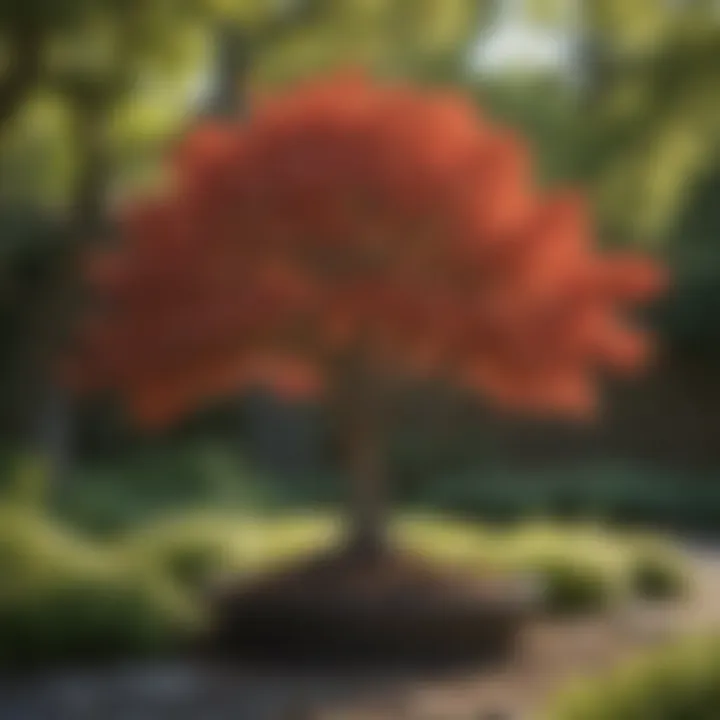Understanding Dwarf Maple Tree Height and Care Tips


Intro
Dwarf maple trees are increasingly gaining popularity among garden enthusiasts and homeowners alike. Their compact size offers versatility in landscaping, making them suitable for various settings. Understanding their height is crucial for effective garden planning and maintenance. This guide will cover the characteristics of dwarf maples, how they grow, environmental influences on their size, and crucial care tips.
The appeal of dwarf maples extends beyond their height. Various types, such as the Japanese Maple and the Garnet Maple, present distinct features and foliage styles. Each possesses unique attributes that can transform any garden space. This article aims to equip readers with the necessary knowledge to cultivate these trees successfully and appreciate their beauty throughout the seasons.
Design Inspiration
Dwarf maple trees can be key components of landscaped environments, providing texture and color. Their varied species allow for creative expression in your outdoor spaces.
Trending Styles
In contemporary landscaping, using dwarf maples can enhance both modern and traditional designs. Homeowners are leaning towards styles that emphasize minimalism and elegance. Here are a few ways to incorporate dwarf maples into your designs:
- Accent Planting: Position them as focal points within flower beds or garden corners.
- Patio Appeal: Dwarf maples can thrive in containers, brightening up patios and balconies.
- Layered Landscapes: Combine different varieties to create layers of color and texture.
Color Palettes
When planning your garden, color palettes are essential. Dwarf maples contribute a spectrum of colors that change with the seasons. For instance:
- Spring: Fresh greens and delicate pinks.
- Summer: Lush greens provide a vivid backdrop.
- Autumn: Rich reds, oranges, and yellows create stunning fall displays.
- Winter: Barren branches can add structure and intrigue.
By considering these trends and color possibilities, you can create a harmonious garden environment.
Practical Tips
Maintaining a dwarf maple involves some consideration regarding their care and requirements.
Maintenance & Care
Regular maintenance is vital for healthy growth. Here are key care tips:
- Watering: Ensuring proper hydration, especially in the first few years.
- Soil Requirements: Well-draining soil is preferable to prevent root rot.
- Pruning: Prune selectively to maintain shape and remove dead wood.
Each of these elements contributes to the overall health and appearance of your dwarf maple.
Budgeting & Planning
To establish dwarf maple trees in your garden successfully, budgeting is necessary. Consider the following when planning:
- Initial Cost: Investment in quality saplings from reputable sources.
- Ongoing Care: Allocate funds for necessary materials such as fertilizers and tools.
- Design Elements: Factor in costs related to landscape design or professional help.
By effectively budgeting, you can ensure that your dwarf maple trees thrive while maintaining fiscal responsibility.
Fact: Dwarf maple trees can live for several decades, making them a long-term investment for your garden.
Foreword to Dwarf Maple Trees
Dwarf maple trees present a unique opportunity for homeowners and gardening enthusiasts seeking to enhance their landscapes. Their compact size makes them ideal for smaller gardens, patios, and urban environments where space is limited. Understanding the characteristics, growth habits, and care requirements of these trees is beneficial for ensuring their health and longevity.
Defining Dwarf Maples
Dwarf maples are varieties of maple trees that have been bred or naturally selected to remain smaller than their standard counterparts. They typically reach a height of two to ten feet, depending on the specific type and growing conditions. These trees maintain the iconic maple foliage and stunning fall colors, making them appealing yet practical choices in landscaping.
Dwarf maples can be broadly classified into several species, such as Japanese maple and sugar maple. Each species exhibits its own unique features, including leaf shape, color, and growth patterns. Understanding these differences is crucial for selecting the right type for a given space, as some varieties may be more suited for certain climates or soil types than others.
Importance in Landscaping
The importance of dwarf maples in landscaping cannot be overstated. Their small stature allows them to fit seamlessly into a variety of designs, from formal gardens to casual settings. Unlike larger trees, dwarf maples can serve as focal points in smaller spaces without overwhelming the area. They also can provide impressive seasonal color changes, especially in the autumn when the leaves transform into vibrant hues of red, orange, and gold.
Dwarf maples can also enhance biodiversity since they attract different forms of wildlife, such as birds and beneficial insects. Furthermore, they can be utilized in combination with other plants to create a visually appealing aesthetic.
Homeowners must consider the placement and growing conditions of their dwarf maples to achieve the best results in their gardens. Understanding how these trees grow and thrive allows for strategic planning in garden design, making it easier to create an attractive outdoor environment that is both functional and beautiful.
Varieties of Dwarf Maple Trees


Dwarf maple trees come in various types, each with distinct characteristics that make them attractive for different gardening needs. Understanding these varieties is essential for anyone interested in cultivating dwarf maples. The choice of variety can influence the height, foliage, and sustainability of the plant in a given environment. Homeowners benefit by selecting a variety that best matches their landscaping goals and climate conditions.
Japanese Maple
Japanese maple trees, especially the dwarf varieties, are celebrated for their delicate leaves and stunning colors. They often feature a range of leaf shapes, from palmate to finely dissected, which adds visual interest. Most varieties tend to grow between three to ten feet tall, making them ideal for smaller gardens or as specimen plants in larger landscapes.
One notable aspect of Japanese maples is their adaptability. They perform well in partial sunlight, though some varieties can tolerate full sun. This flexibility allows gardeners to place them in various locations without significant concern about height restrictions or shading.
The Acer palmatum 'Shishigashira' and Acer palmatum 'Crimson Queen' are examples of popular dwarf Japanese maples. Their unique growth forms and vibrant fall color make them ideal for accentuating garden features. Regular pruning can enhance their shape and promote healthy growth.
Sugar Maple
Sugar maple trees, traditionally known for their larger stature, also have dwarf varieties that maintain the unique characteristics of the species. These dwarf sugar maples grow to about six to eight feet tall. Their leaves are distinguished by their vibrant green color during the summer months, transforming into brilliant shades of yellow and orange in autumn.
Dwarf sugar maples adapt well to various soil types and can thrive in both sunny and partially shaded areas. Their ability to survive in different conditions makes them a favorable choice for homeowners. They also attract various wildlife, offering ecological benefits.
The Acer saccharum 'Green Mountain' is one such example of a dwarf sugar maple. It remains compact yet boasts the same hardy characteristics as its larger relatives. Proper care will ensure a healthy, vibrant tree that can serve as a central feature in any garden.
Amur Maple
The Amur maple is a lesser-known but equally appealing choice among dwarf maples. They often grow to a height of around six to ten feet. This species is resilient and can adapt well to a variety of environmental conditions. It is particularly tolerant of harsh weather, making it a good option for regions with extreme temperatures.
Amur maples have a dense growth habit and smaller, rounded leaves that turn a lively red in the fall. Their smaller size and unique form contribute to their popularity in landscape design.
The Acer ginnala 'Flame' is a well-regarded cultivar that embodies these traits. Amur maples have fewer pest issues, which can simplify maintenance for gardeners. They often thrive in a range of soil types, even those that are less favorable for other maple varieties.
In summary, these dwarf maple varieties not only enhance aesthetics but also offer ecological advantages, making them a valuable asset in any garden setting. Valuing the specific characteristics of each can lead to informed decisions that result in successful cultivation.
Growth Characteristics of Dwarf Maples
Understanding the growth characteristics of dwarf maple trees is vital for anyone interested in landscaping and gardening. The height and overall structure of these trees are influenced by multiple factors. Recognizing these traits helps in the selection and care of these trees for optimal growth and aesthetic appeal.
Typical Height Ranges
Dwarf maple trees generally exhibit a height range that distinguishes them from their taller counterparts. Typically, these trees grow between 3 to 10 feet in height, depending on the variety. For example, the popular Japanese Maple, particularly the dissected leaf varieties, can reach up to 10 feet but often stays closer to 6 feet. On the other hand, some cultivars like the Little Baby Butterfly can be as short as 3 feet. This variability allows gardeners to select plants that fit specific spaces and design goals.
While the height might vary, the compact form of dwarf maples makes them suitable for small gardens, patios, and urban landscapes. Maintaining a shorter stature is often preferred for limited spaces, and understanding typical height ranges can help in planning.
Factors Influencing Growth
Several factors significantly influence the growth of dwarf maples. Among them are genetic factors, environmental conditions, and soil quality. Each of these factors plays a critical role in determining how well these trees thrive.
Genetic factors
Genetic traits of a specific dwarf maple variety largely dictate its growth patterns. Some varieties have been intentionally bred to maintain a smaller size, making them ideal for space-limited gardens. The genes dictate not just height but also branching structure and leaf size. For instance, cultivars like 'Mikawa Yatsubusa' are known for their dense canopy and compact growth, which can enhance garden aesthetics. The unique feature of these genetic traits is their stability; selecting a dwarf variety means consistent performance in height.
However, this can also have disadvantages. Limited genetic diversity can sometimes lead to susceptibility to certain diseases and pests. Still, many gardeners value this predictability, as it often means easier maintenance and care.
Environmental conditions
Environmental factors are another critical element affecting the growth of dwarf maple trees. Dwarf maples thrive in well-drained, slightly acidic soil with adequate sunlight. They often prefer climates characterized by warm summers and moderate winters. This condition can greatly influence their growth rates and health.
A key characteristic of environmental conditions is their dynamic nature. Changes in weather patterns, humidity, and temperature all play a role. Maples exposed to full sun tend to grow more vigorously than those in partial shade. Conversely, excessive heat or prolonged cold can stunt growth. Understanding these conditions allows for better planning and care for the tree's needs throughout its life cycle.
Soil quality
Soil quality is crucial for the healthy growth of dwarf maples. The ideal soil type is well-drained, enriched with organic matter, and maintains a slightly acidic pH. Good soil quality ensures that tree roots access necessary nutrients and water. Fertile soil promotes root development, which in turn impacts the overall height and health of the tree.
A unique feature of high-quality soil is its capacity to retain moisture while also providing sufficient drainage. If soil becomes compacted or too heavy, it can lead to root rot. Poor soil quality will often manifest as stunted growth and discolored leaves, marking it as an area for improvement. Therefore, ensuring optimal soil conditions is a necessity for anyone looking to cultivate these trees successfully.
"A vital understanding of soil quality can translate directly into the long-term health and stature of dwarf maples."
In summary, grasping the growth characteristics, including height ranges and the influencing factors, is essential for both novice and experienced gardeners. This knowledge aids in making informed decisions regarding the selection and care of dwarf maple trees.
Climate Considerations for Dwarf Maples
When cultivating dwarf maple trees, understanding climate considerations is paramount. Dwarf maples exhibit specific growth patterns that are often dictated by external temperature, humidity, and seasonal changes. A favorable climate not only promotes optimal growth but also helps ensure that these trees flourish and remain healthy over time. The wrong climate can lead to stunted growth and make them prone to diseases, hindering their ability to thrive in gardens.


Preferred Climate Zones
Dwarf maples are generally adaptable; however, they do best in temperate climates. Regions with a balance of warm summers and cold winters are ideal. This allows the trees to experience a natural dormancy cycle.
- USDA Hardiness Zones: Most dwarf maples prefer zones 4 through 8.
- Moisture: Regular rainfall or sufficient irrigation helps maintain healthy soil moisture, which is crucial for their growth.
- Sunlight: These trees thrive with partial shade, especially in hotter climates, as too much sunlight can scorch their leaves.
The key to selecting the right climate zone involves analyzing local temperatures and seasonal weather patterns thoroughly. Regions that suffer from extreme fluctuations may damage the roots and can lead to undesired results in growth cycles.
Impact of Climate on Growth
Climate has a significant impact on the height and overall growth of dwarf maple trees. The following factors are particularly influential:
- Temperature Changes: Extreme cold or heat can affect growth rates. Cold spells may cause frost damage while excessive heat can lead to dehydration.
- Humidity Levels: Higher humidity can encourage better growth, whereas low humidity may lead to wilting or drying out, affecting leaf quality.
- Precipitation Patterns: Adequate rainfall is necessary. Insufficient water leads to stress, which can stunt growth and impact the aesthetic qualities of the leaves.
"Understanding the climate needs is a foundation for successful dwarf maple tree care. Proper climate assessment gives the trees a better chance to thrive and flourish."
In summary, assessing climate conditions can drastically improve the success rate of growing dwarf maples. Homeowners and gardening enthusiasts must take time to study their local environment. This knowledge translates directly to better care practices, enabling them to enjoy these remarkable trees in their gardens.
Soil and Water Requirements
Dwarf maple trees thrive best when their soil and water needs are properly addressed. These factors play a critical role in their overall health, growth, and resilience. Inadequate or overly wet soil can lead to issues such as root rot, stunted growth, and diminished vitality. Understanding the suitable soil conditions and proper watering techniques is essential for ensuring these trees reach their full potential.
Ideal Soil Types
Dwarf maple trees prefer well-draining soil that maintains a balanced moisture level. The best soil type for these trees includes:
- Loamy Soil: This type offers a mix of sand, silt, and clay, facilitating good drainage while still retaining necessary nutrients.
- Sandy Soil: While it drains quickly, it often need additional organic matter to retain moisture and nutrients.
- Clay Soil: When amended with compost, this soil can support dwarf maples by improving drainage and nutrient availability.
When planting dwarf maples, it is advisable to perform a soil test. This helps determine pH levels and nutrient composition, allowing for adjustments that suit the specific needs of the chosen variety. A slightly acidic to neutral pH, ranging from 6.0 to 7.0, is generally favorable for these trees.
Irrigation Needs
Irrigation is vital for dwarf maples, particularly during the tree's early establishment phase. Adequate watering ensures that the soil remains moist, which is crucial for healthy root development. Factors affecting irrigation needs include:
- Age of the Tree: Young trees require more frequent watering as their root systems are not fully established. Typically, weekly watering is needed during dry spells.
- Climate Conditions: In hot July or August months, increased watering might be necessary, especially if rainfall is insufficient.
- Soil Type: Different soil types drain moisture at varying rates. Sandy soils need more frequent watering compared to heavier clay soils that retain moisture for longer periods.
For optimal results, use a soaker hose or drip irrigation system. This method provides slow and deep watering, promoting strong root growth without causing waterlogging around the roots.
Key Takeaway: Consistently monitoring soil quality and moisture levels can greatly affect the well-being of dwarf maple trees. Adjusting care based on seasonal changes ensures their health throughout the years.
Pruning Techniques for Dwarf Maples
Pruning is a critical aspect of maintaining the health and aesthetics of dwarf maple trees. Proper pruning techniques help shape the tree, encourage robust growth, and ensure the tree remains at a desirable height and form. Understanding when and how to prune these plants is essential for both novice and experienced gardeners.
When to Prune
Timing is crucial in the pruning process. The best time to prune dwarf maple trees is during late winter or early spring, prior to new growth. During this phase, the trees are still dormant, reducing the risk of sap bleeding and allowing for better healing of the cuts.
Pruning during early spring not only promotes a healthier shape, but also ensures that the tree has enough time to heal before it enters the growing season. Early signs of new growth appearing on the buds indicate that it is the right time to commence pruning. Avoid pruning in late fall, as this can expose fresh cuts to the harsh winter conditions and may impair the tree’s health.
Pruning Methods
There are several effective methods for pruning dwarf maple trees. Each technique serves distinct purposes and should be considered based on the desired outcome:
- Thinning: This method involves selectively removing branches to improve air circulation and light penetration. It helps to prevent diseases and promote an open canopy.
- Heading: This technique shortens the length of branches and encourages bushier growth. Heading should be done cautiously to avoid shock to the tree.
- Pinching: This is the practice of removing the tips of young shoots, often used to encourage fuller growth. It is more appropriate for smaller plants or younger trees.
Before starting any pruning, it is advisable to use clean and sharp tools. Proper cuts should be made just above a bud, which ensures that the tree can heal effectively. Additionally, avoid leaving stubs that may become entry points for pests or disease.
Proper pruning enhances visual appeal and health of the tree, making it an integral part of caring for dwarf maples.
Pest and Disease Management
Pest and disease management is crucial for maintaining the health and appearance of dwarf maple trees. Small pests and diseases can lead to significant problems if not addressed quickly. Effective management not only protects the trees but also ensures they remain an attractive feature in any landscape. Different types of insects and pathogens can adversely affect the growth and overall vitality of dwarf maples, making it essential for homeowners to recognize the signs of trouble early on.
Here, we will explore common pests that affect dwarf maples and preventive measures that can be taken to mitigate these issues.


Common Pests
Dwarf maple trees are often attractive to various pests. Identifying these pests early can make a significant difference in management effectiveness. Some of the common pests that one may encounter include:
- Aphids: These small, soft-bodied insects feed on the sap from leaves, which can lead to leaf curling and yellowing.
- Spider Mites: Though not insects, these tiny arachnids suck sap from leaves, causing stippling and can lead to leaf drop.
- Scale Insects: They attach firmly to stems and leaves, feeding on sap and potentially causing dieback.
- Leafhoppers: These insects can cause damage by transmitting disease and directly feeding on foliage.
Each of these pests can pose serious threats to dwarf maples, resulting in weakened trees that may struggle to thrive.
Preventive Measures
Taking preventive measures is vital to keeping dwarf maples healthy. Some effective strategies include:
- Regular Inspections: Periodically check your trees for any signs of pests. Early detection helps in addressing the issue before it escalates.
- Maintaining Good Air Circulation: Ensuring adequate space around each plant minimizes humidity and prevents pests from thriving.
- Using Organic Insecticides: For more serious infestations, consider applying organic insecticides that are less harmful to the environment.
- Promoting Beneficial Insects: Encourage natural predators like ladybugs and lacewings, which feed on pests like aphids.
- Proper Pruning Practices: Regularly prune the trees to remove dead or diseased branches, which can attract pests.
"A proactive approach to pest management can save your dwarf maple trees from significant harm and enhance their longevity."
By actively managing pests and implementing preventive techniques, homeowners can enjoy the beauty of their dwarf maples while minimizing the risk of disease and pest infestation.
Potential Issues with Dwarf Maples
Understanding the potential issues with dwarf maples is crucial for ensuring their health and longevity. These trees, while generally hardy and low-maintenance, can face specific challenges that impact their growth and overall vigor. Addressing these issues is essential for gardeners and homeowners who wish to maintain the aesthetic and functional aspects of their landscape. By recognizing symptoms early and implementing appropriate solutions, one can greatly improve the resilience of these trees.
Stunted Growth Factors
Stunted growth in dwarf maples can be attributed to several factors. One of the primary reasons is insufficient nutrients in the soil. These trees thrive in well-balanced soil that is rich in organic matter. When the nutrient content is low, growth may slow significantly.
- Nutrient Deficiencies: Inadequate nitrogen, phosphorus, or potassium can stunt growth. Regular soil tests can determine nutrient levels.
- Improper pH Levels: Dwarf maples prefer slightly acidic to neutral soil. If the pH is too high or too low, nutrient uptake can be compromised.
- Root Bound Conditions: If the tree is planted in a container and remains there too long, roots may become overly compacted, leading to stunted height and inadequate growth.
Another factor to consider is the tree's exposure to sunlight. Dwarf maples require adequate light for optimal growth. If planted in shaded areas or under the canopy of larger trees, they may not receive enough sunlight, leading to weak and spindly growth. Regular observation of the tree’s condition allows for adjustments in placement if necessary.
Environmental Stressors
Various environmental stressors can adversely affect dwarf maples. These trees may be sensitive to extreme weather conditions or rapid changes in their surroundings.
- Soil Moisture Levels: Dwarf maples need consistent moisture. Inadequate watering during dry periods can lead to stress, while overwatering can cause root rot, both of which hinder growth.
- Temperature Fluctuations: Sudden temperature changes can shock the trees, affecting their health and growth patterns. This is especially critical in the late winter or early spring when thawing begins.
- Pest Infestation: Insect pests, such as aphids or whiteflies, can weaken the trees by draining their vitality. Regular inspection for pests is important for the early detection of infestations.
- Diseases: Fungal infections can spread rapidly in damp conditions. Maintaining proper air circulation and monitoring signs of disease can prevent serious issues.
The Role of Dwarf Maples in Garden Design
Dwarf maple trees play a significant role in garden design, offering various advantages for landscape planning. Their unique characteristics, such as compact size and diverse foliage colors, make them valuable assets. Garden designers and homeowners increasingly recognize how these trees can enhance visual aesthetics and improve spatial dynamics in outdoor spaces. Dwarf maples can provide structure to smaller gardens and soften the harsh lines often present in urban landscaping.
Creating Visual Interest
Dwarf maples contribute striking visual elements due to their variegated leaves and seasonal color changes. In spring, new foliage bursts forth in vibrant hues of red and green, while autumn transforms these trees into a palette of gold, orange, and crimson. This seasonal shift brings continuous visual appeal, attracting attention at different times of the year.
When placing dwarf maples, consider positioning them at focal points within a garden. Their rounded forms can create natural focal points, drawing the eye while framing other plants. The contrast between the delicate leaves and the structured elements in the garden enhances overall beauty. Utilize group plantings to create layers of colors and textures, further boosting visual interest.
Integrating with Other Plants
Integrating dwarf maples with other plants requires careful planning. The compatibility of neighboring species is crucial for achieving a harmonious design.
- Consider perennial flowers such as hostas or daylilies, which can complement the bold colors of the maple's leaves.
- Grasses like Japanese Blood Grass can provide an enchanting contrast.
- For a vertical element, pairing with ornamental shrubs can create depth in your landscape.
Ensure that each plant's growth habits are understood. This understanding helps in planning spacing and light requirements accordingly. Dwarf maples thrive in partial shade to full sun, while neighbors may have specific needs regarding sunlight and moisture.
Overall, dwarf maples serve as versatile elements in garden design, enriching both the visual appeal and plant variety. Careful integration of these trees with other plants can lead to stunning landscapes that are both balanced and thriving.
Ending
The topic of dwarf maple trees and their height is important for many who engage in landscaping and gardening. Dwarf maples are not merely ornamental; they serve a functional role in garden design, enhancing aesthetic appeal while also offering practical benefits. Understanding their characteristics and growth patterns allows homeowners to cultivate these trees more effectively, ensuring they thrive in their environment.
Summary of Key Points
- Dwarf maple trees vary in height, typically ranging from three to ten feet, depending on the species and growing conditions.
- Their height is influenced by genetic factors, environmental conditions like sunlight and wind exposure, and soil quality.
- Proper care, including watering, soil maintenance, and appropriate pruning, contributes significantly to achieving desired height and health.
- Recognizing pests and diseases is crucial for maintaining the vitality of dwarf maples, as these issues can stunt their growth.
- Integrating dwarf maples into garden designs creates visual interest and complements other plant types.
Future Trends in Dwarf Maple Cultivation
Looking forward, the cultivation of dwarf maples is likely to evolve in several ways. Sustainable practices will likely gain more traction among gardeners. This may include organic pest management and the use of native soil amendments to enhance growth.
Moreover, there could be increased interest in breeding new varieties with even smaller growth habits, making them suitable for urban settings where space is limited. As enthusiasts seek to create unique landscapes, hybrid varieties might also see a rise in popularity.
Climate change can also affect cultivation trends. Home gardeners may need to adapt to changing conditions by selecting more resilient species or improving care practices to mitigate environmental stressors. This adaptability could become a focal point for future discussions within gardening communities.
The future of dwarf maple tree cultivation will not only rely on aesthetic choices but also sustainable and practical approaches that meet the needs of both gardeners and the environment.















